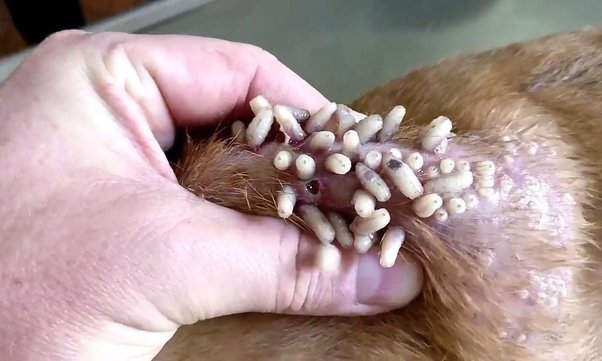Every dog owner knows their faithful canine companions frequently prey on parasitic worms. Roundworms, tapeworms, and hookworms are the most common culprits, with heartworms being the most dangerous due to their potential fatality.
Have you ever heard the strange term “mango worms”? Mango worms, as opposed to worms that usually enter other physiological systems, such as the digestive tract, live within the dog’s skin.
However, while mango worms may not constitute a serious threat, underestimating their impact and leaving them untreated can cause severe discomfort for your pet, marked by intense skin irritation and your dog’s obvious distress.

Investigating the Complexities of Mango Worm Parasites in Dogs
You may be familiar with parasites that affect dogs, such as the dreaded ringworm. Mango worms, though less well-known, are surprisingly common offenders.
Mango worms prefer skin and fur, unlike many other parasites that feed on the gastrointestinal tract.
These parasites originated on the African continent and are informally known as mango flies, a phrase derived from their classification as tropical blowflies. Surprisingly, they seek refuge in a dog’s skin because of its nutritional richness, relying on this resource to support their growth.
During their larval stage, predatory infiltration happens when they infiltrate the skin and consume the surrounding tissue, establishing a parasitic relationship with the host.
Mango Worm Mysteries in the United States
Mango worms are much less common in the United States than in Africa. If you live on the African continent, your canine companion is much more likely to come into contact with mango worms than peers from other places.
Mango worms are regularly observed in Uganda and South Africa. If you live in these or comparable places characterized by increased mango worm activity, your dog may have a higher risk of succumbing to this infestation.

The Difficulties of Mango Worm Infestation in Dogs
Mango worms usually seek shelter in the dirt, mainly if it contains traces of excrement or urine.
The parasites lay their eggs in this soil and then look for a suitable host – a canine friend. This preference for canine skin can be related to its importance for canine skin.
Dogs’ intrinsic affinity for playing in the dirt is evident to every dog owner. Because of their fun, they frequently come into contact with mango worm larvae, which hatch and burrow into the skin, causing discomfort and misery in the host.
The larvae feed on the host’s tissue to help them grow, producing a red boil that contains a maggot-like worm. When these larvae reach adulthood, they break the skin, completing the mango worm’s lifespan within the host.
Deciphering the Symptoms of Mango Worm Infestation
Detecting the existence of mango worms in your dog might be difficult because the early stages of infection may be symptom-free. Symptoms appear only after the mango worm larvae have matured and begun to emerge.
Itching, skin redness, blisters or boils, sleep difficulties, fever, and behavioral changes are common symptoms of a mango worm infestation. Dogs with mango worms frequently exhibit excessive scratching, efforts to relieve discomfort by biting at their skin, and an overall sense of unease.
Mango Worm Removal Techniques for Your Dog
If you suspect your dog has a mango worm infection, seek competent veterinary assistance immediately.
Veterinarians are trained to decide the best course of therapy, and it is critical not to attempt any corrective activities alone. Uninformed intervention could result in severe infections in your pet.
Veterinarians routinely offer specialized injections, including chemicals like adrenaline and lidocaine, to combat mango worm larvae. These injections are excellent in promoting parasite larvae elimination.
Alternatively, certain situations necessitate the removal of each boil’s scab, followed by applying substances such as sterile wax or jelly. This method suffocates the larvae while pinpointing their exact location, as the unmistakable black spots demonstrate.
Another viable method involves carefully extracting larvae by squeezing boils or pimples. A sterile procedure is required to prevent secondary infections and ensure the thorough removal of each larva.
Awareness of the risk of skin infections caused by mango worm infestations is critical. The presence of these parasites causes substantial irritation, and any introduction of bacteria could lead to a life-threatening illness in your pet.
Boosting Your Dog’s Immunity Against Mango Worms
Vigilance against mango worm infestations is dependent on recognizing their source – soil.
Limiting your dog’s exposure to potentially contaminated soil, particularly soil containing traces of excrement or pee, is a preventive approach. Restricting your dog’s exposure to such situations can dramatically reduce the likelihood of an infection.
Grooming and maintaining your dog’s coat regularly is critical. You help their overall well-being by keeping their coat and skin clean, thereby increasing their resilience to infestations.
Can Mango Worms Spread Their Influence on Humans?
The likelihood of mango worms infesting people is negligible. Humans lack the characteristic fur that parasites grab onto to gain access to the skin, and they do not participate in enthusiastic soil-bound activities like dogs.
However, there is a possibility that humans will unintentionally become mango worm hosts. A transfer could occur if one’s clothing touches mango fly eggs.
For example, drying garments in a mango fly-infested environment could transmit these eggs into the clothing, providing a danger of infestation.
Parting Thoughts: Solving the Mango Worm Mystery in Dogs
The findings thus far highlight the seriousness of mango worm infestations in canines. While they may be rare in the United States, understanding this issue is critical.
Proactive awareness against skin infestations in pets is critical for people who live in mango worm-prone areas. If your dog exhibits any signs of infestation, seek immediate medical care.





